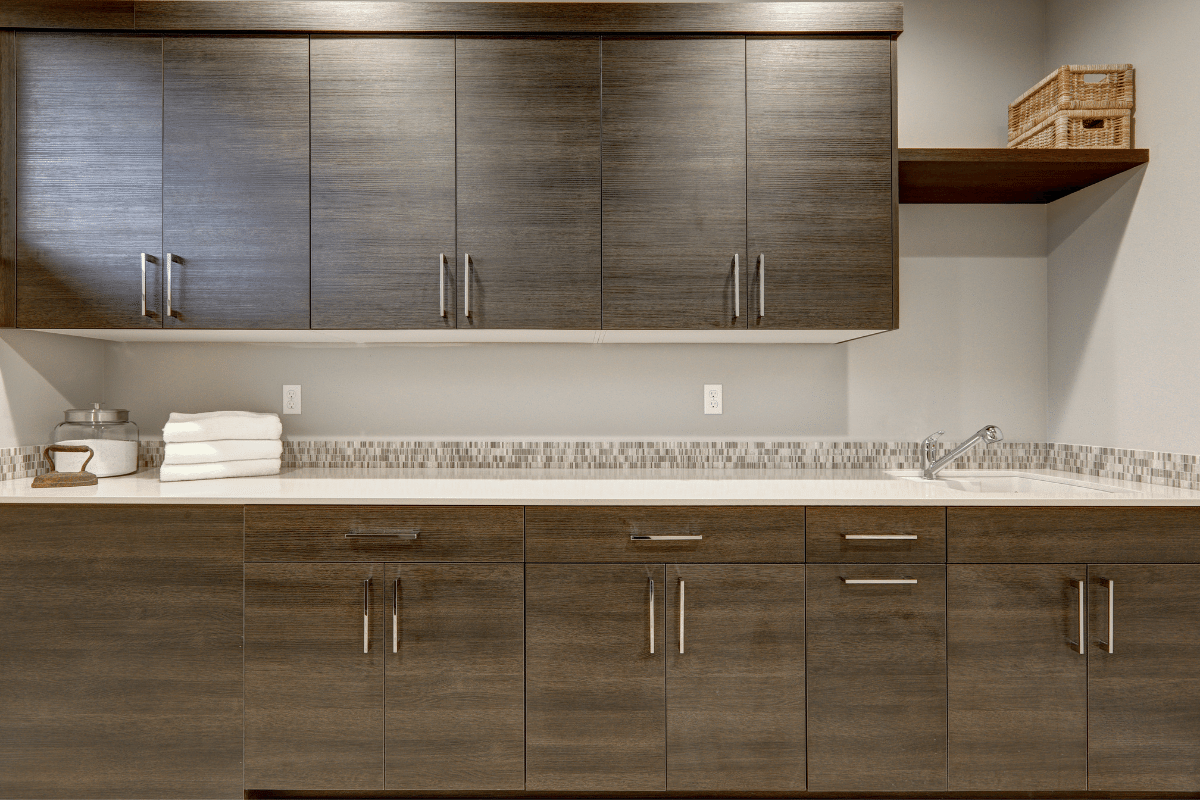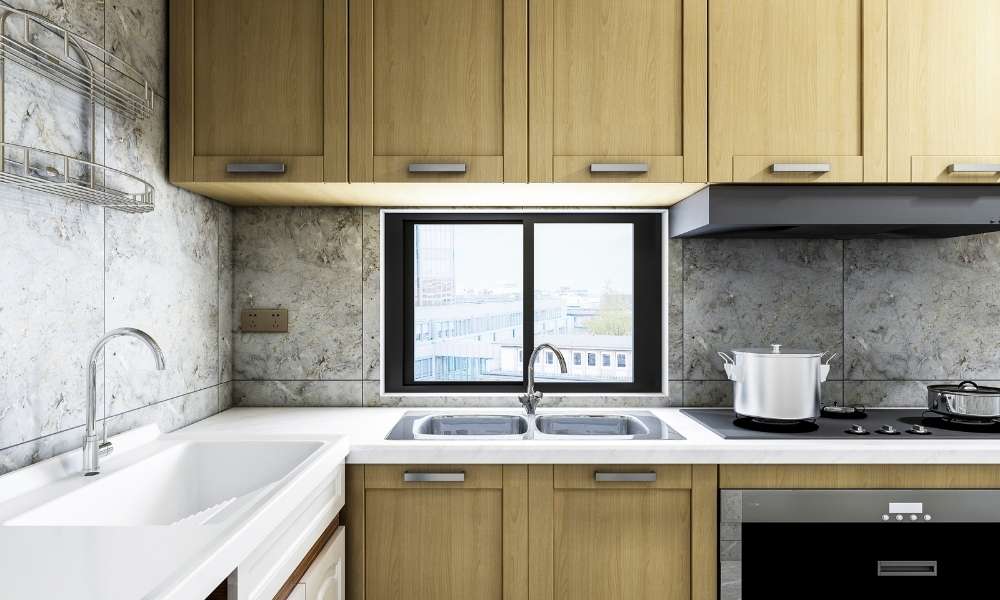Understanding Wood Veneer Cabinets

Wood veneer cabinets are a popular choice for homeowners who want the look of solid wood without the high price tag. Veneer is a thin layer of wood that is glued to a core material, such as plywood or particleboard. This creates a durable and aesthetically pleasing surface that can be stained or painted to match any décor.
Characteristics of Wood Veneer
Wood veneer offers a range of characteristics that make it suitable for cabinet construction. The thin sheets of wood are carefully selected for their grain patterns, color, and texture, allowing for a wide variety of finishes. Veneer is also relatively lightweight, making it easier to work with and install. Moreover, it is less susceptible to warping and cracking compared to solid wood, especially in humid environments.
Benefits and Drawbacks of Wood Veneer Cabinets
- Cost-effective: Wood veneer cabinets are significantly less expensive than solid wood cabinets, making them an accessible option for many homeowners.
- Aesthetic appeal: Veneer offers a wide range of wood species, grain patterns, and finishes, allowing for customization to match any style.
- Durability: When properly cared for, wood veneer cabinets can last for many years, providing a durable and long-lasting solution.
- Stability: The core material used in veneer construction provides stability and reduces the risk of warping or cracking.
- Lightweight: Veneer is relatively lightweight, making it easier to work with and install, particularly in older homes with existing cabinets.
- Susceptibility to damage: While veneer is durable, it can be susceptible to scratches and dents, especially if not properly maintained.
- Limited refinishing options: Unlike solid wood, veneer cannot be refinished multiple times due to its thin layer of wood.
- Potential for delamination: If the adhesive used to bond the veneer to the core material fails, the veneer can delaminate, leading to damage and aesthetic issues.
Examples of Wood Veneer Finishes
Wood veneer finishes can range from simple stains to complex lacquers and paints. Each finish has its own maintenance requirements, which should be considered when choosing veneer cabinets.
- Stained veneer: Stained veneer cabinets offer a natural look and highlight the wood’s grain pattern. Regular dusting and occasional cleaning with a damp cloth are recommended for maintenance.
- Lacquered veneer: Lacquered veneer provides a durable and glossy finish that is resistant to scratches and spills. Regular dusting and occasional cleaning with a mild soap and water solution are sufficient for maintenance.
- Painted veneer: Painted veneer offers a versatile option for creating a variety of looks. Regular dusting and occasional cleaning with a damp cloth are recommended for maintenance. However, avoid abrasive cleaners, as they can damage the paint.
Basic Cleaning Techniques: How To Clean Wood Veneer Cabinets

Cleaning wood veneer cabinets requires a gentle approach to preserve their beauty and longevity. Using the right cleaning supplies and techniques will ensure your cabinets maintain their luster and shine.
Cleaning Supplies
Choosing the right cleaning supplies is crucial for effective and safe cleaning of wood veneer cabinets. The following supplies are essential:
- Microfiber cloth: Microfiber cloths are highly absorbent and effective at removing dust, dirt, and fingerprints without scratching the delicate veneer surface. Look for cloths specifically designed for cleaning wood surfaces.
- Soft-bristled brush: A soft-bristled brush is useful for reaching into crevices and corners, gently dislodging dust and debris. Avoid brushes with harsh bristles, which can damage the veneer.
- Wood cleaner: A specialized wood cleaner is recommended for removing dirt and grime without stripping the protective finish. Look for cleaners formulated for wood veneers and avoid harsh chemicals like ammonia or bleach. Popular brands include Howard’s Feed-N-Wax, Murphy Oil Soap, and Old English Scratch Cover.
- Distilled water: Distilled water is ideal for rinsing away cleaning solution residue and preventing water spots.
- White vinegar: White vinegar is a natural cleaner that can be used to remove sticky residue or stubborn stains. Dilute it with water (1:1 ratio) before applying it to the cabinets.
Cleaning Procedure
A systematic cleaning approach ensures that every part of the cabinet is thoroughly cleaned. Here’s a step-by-step guide:
- Dusting: Begin by dusting the cabinets with a dry microfiber cloth to remove loose dust and debris. Pay attention to the top of the cabinets, corners, and crevices. Use a soft-bristled brush to reach into tight spaces.
- Cleaning: Apply a small amount of wood cleaner to a damp microfiber cloth. Avoid soaking the cloth, as excess moisture can damage the veneer. Wipe the cabinets in the direction of the wood grain, using gentle strokes.
- Rinsing: Wipe the cabinets with a damp cloth soaked in distilled water to remove any cleaning solution residue. Dry the cabinets thoroughly with a clean microfiber cloth.
- Polishing: For added shine, you can apply a wood polish specifically designed for veneers. Apply a small amount to a clean cloth and rub it into the cabinets in the direction of the wood grain.
Cleaning Specific Areas
Different areas of the cabinets may require special attention:
- Cabinet doors: Focus on cleaning the handles and knobs thoroughly, as these areas tend to accumulate fingerprints and smudges. Use a damp microfiber cloth and a mild wood cleaner to clean them.
- Shelves: Clean shelves regularly to prevent dust and debris from accumulating. Use a damp microfiber cloth and a mild wood cleaner to wipe them down. For stubborn stains, use a diluted white vinegar solution.
- Inside cabinets: Dust the inside of the cabinets regularly, especially if you store food items. Use a damp microfiber cloth to wipe down the shelves and walls.
Advanced Cleaning and Restoration

Once you’ve mastered the basic cleaning techniques, you can delve into more advanced methods for restoring your wood veneer cabinets to their former glory. This section will guide you through removing stubborn stains and scratches, maintaining the shine with wood polish and conditioners, and repairing minor damage like chipped edges or peeling veneer.
Removing Stubborn Stains and Scratches, How to clean wood veneer cabinets
Stubborn stains and scratches can mar the beauty of your wood veneer cabinets. Fortunately, there are effective methods for addressing these imperfections.
- For stains, start by gently wiping the affected area with a damp cloth. If the stain persists, try a mild soap solution or a specialized wood cleaner. Avoid abrasive cleaners, as they can damage the veneer. For deeper stains, consider using a paste made from baking soda and water, applying it to the stain and letting it sit for a few minutes before gently scrubbing with a soft cloth.
- For scratches, a wood filler can help to conceal them. Choose a filler that matches the color of your veneer and apply it carefully to the scratch, following the manufacturer’s instructions. After the filler dries, sand it lightly with fine-grit sandpaper to blend it in with the surrounding surface.
Using Wood Polish and Conditioners
Regular application of wood polish and conditioners helps to maintain the shine and protect your wood veneer cabinets from damage.
- Wood polish creates a protective layer that enhances the natural beauty of the wood and helps to resist dust and fingerprints. Apply polish with a soft cloth, working in the direction of the wood grain.
- Wood conditioner nourishes the wood, preventing it from drying out and cracking. Conditioners typically contain oils and waxes that penetrate the wood and restore its natural moisture balance. Apply conditioner according to the manufacturer’s instructions, allowing it to soak into the wood before wiping away any excess.
Repairing Minor Damage
While minor damage like chipped edges or peeling veneer can be unsightly, they are often repairable with the right techniques.
- For chipped edges, use wood glue to reattach the chipped piece. Apply glue to both the chipped piece and the cabinet surface, then carefully press them together. Clamp the pieces in place until the glue dries completely. Once the glue is dry, sand the repaired area to blend it in with the surrounding surface.
- For peeling veneer, use a heat gun to gently warm the peeling veneer. As the veneer softens, use a putty knife to carefully press it back down onto the cabinet surface. Once the veneer is secured, use a wood glue to reinforce the bond. Allow the glue to dry completely before sanding the repaired area.
How to clean wood veneer cabinets – Cleaning wood veneer cabinets is a breeze with the right tools and techniques. A gentle cloth and a mild soap solution are all you need to remove dust and grime. If you’re looking for a vintage touch for your bathroom, consider adding a vintage wood medicine cabinet.
These charming cabinets can add a touch of nostalgia to any space. Once you’ve chosen your vintage cabinet, remember to clean it with the same care you’d give your other wood veneer pieces.
Cleaning wood veneer cabinets is a breeze, especially if you avoid harsh chemicals. A simple mix of mild soap and water will do the trick. But if you’re struggling with space, consider a mezzanine in your small bedroom for extra storage.
Once you’ve got your storage sorted, you can focus on keeping those wood veneer cabinets sparkling clean and free of dust!
